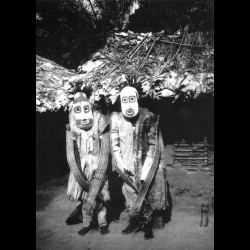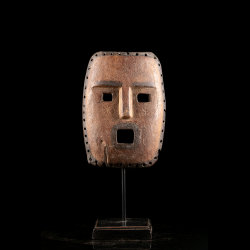















African mask from the Democratic Republic of Congo originating from the northern region of Biangolo. More precisely, it comes from the Kumu ethnic group (or Komo). This ibole or nsembu-type mask was worn during the dances of the divinatory association Nkunda.
The masks danced in pairs: biangolo (masculine) and ibole (feminine).
Kumu masks, characterized by marked polychromy, showcase a unique and distinctive aesthetic. Originating from the Democratic Republic of Congo, these masks are distinguished by a flat and expressive face, capturing the essence of Kumu artistic creativity. The toothed mouth and gaping eyes add a striking dimension to the facial expression, creating a mystical and powerful aura.
The pronounced polychromy of Kumu masks involves skillful use of vibrant and contrasting colors, not only drawing attention but also conveying deep symbolic meanings. These masks are often infused with cultural and spiritual symbols specific to the Kumu tradition, making them much more than mere visual art. Kumu masks, with their characteristic flat and expressive faces, toothed mouths, and gaping eyes, embody the cultural and spiritual richness of this African artistic community.
Data sheet
You might also like

African mask from the Democratic Republic of Congo originating from the northern region of Biangolo. More precisely, it comes from the Kumu ethnic group (or Komo). This ibole or nsembu-type mask was worn during the dances of the divinatory association Nkunda.
The masks danced in pairs: biangolo (masculine) and ibole (feminine).
Kumu masks, characterized by marked polychromy, showcase a unique and distinctive aesthetic. Originating from the Democratic Republic of Congo, these masks are distinguished by a flat and expressive face, capturing the essence of Kumu artistic creativity. The toothed mouth and gaping eyes add a striking dimension to the facial expression, creating a mystical and powerful aura.
The pronounced polychromy of Kumu masks involves skillful use of vibrant and contrasting colors, not only drawing attention but also conveying deep symbolic meanings. These masks are often infused with cultural and spiritual symbols specific to the Kumu tradition, making them much more than mere visual art. Kumu masks, with their characteristic flat and expressive faces, toothed mouths, and gaping eyes, embody the cultural and spiritual richness of this African artistic community.
